
|
Sale 34
Pre-Long Beach Coin and Currency Auction
| Lot |
Photo |
Description |
Realized |
Lot 797 |
 |
1838 Pattern Half Dollar. Silver, reeded edge. PCGS graded Proof 62. A trifle soft in the centers as made. Lots of flashy mirror surfaces. This handsome rarity is a restrike from the second die only with straight date. According to Judd, "originals may exist but none seen to date. Always weak in centers." Of course, the word "always" has minimal significance to the Judd-80 half dollar since the coin is rated Rarity-8, with only two listed as known to Judd, the 1976 ANA specimen and one in the Witham Collection! A refreshingly attractive design in which the obverse mimics closely the regular seated Liberty of the Gobrecht dollars as well as that adopted in 1839 for the half dollar. LIBERTY is in incuse lettering on the ribbon on Judd-80. The reverse displays the "defiant" eagle holding an olive branch and six arrows in its claws and is one of Gobrecht's starring designs. Another version of this eagle has it soaring on the Judd-79 and Gobrecht dollar patterns. Pop 1, 1 in PF63 only 2 graded at PCGS. (PCGS # 11332) .
Estimated Value $15,000 - 17,500.
View details and enlarged photos
Check results on similar lots
| Realized
$17,250 |
Lot 798 |
|
1854 Pattern Cent. Bronze, plain edge. PCGS graded Proof 64 Brown. Rarity 4. Lovely shades of brown and iridescent blue toning with a speck of mint red here and there. A popular transition piece between the outdated large cent and the soon-to-be small cents of 1856-1864. Pop 40; 10 in 65 BN; 3 in 66 BN. (PCGS # 11663) .
Estimated Value $1,200 - 1,500.
View details
Check results on similar lots
| Realized
$1,438 |
Lot 799 |
|
1859 Pattern Double Eagle. Copper, reeded edge. NGC graded Proof 64. Struck in 1859 but bearing no date, this interesting pattern for a double eagle is a mule of the Anthony Paquet-designed Liberty seated design with the regular reverse of 1859 by Longacre. Pop 3; tied for the finest
The engraver is one of relatively few assistants at the Mint who never achieved the chief engravership position, but whose name is a numismatic byword today. Although Anthony C. Paquet signed many medals at the Philadelphia Mint, including the particularly important Washington Cabinet Medal for presentation on February 22, 1860, his patterns are unsigned. Among patterns attributed to Paquet are certain cent dies circa 1858, pattern half dollars and this $20 coin of 1859, several issues of the 1860s, and at least one 1877 half dollar, among others. Dies employing tall letters with thick uprights are often attributed to him, and in the case of certain 1859 half dollars and of the 1861 Paquet Reverse $20 this is correct. Others may have been from punches that Paquet made, but which were employed by different artists.
Estimated Value $9,000 - 12,000.
View details
| Realized
$23,000 |
Lot 800 |
|
1867 Pattern Silver Dollar. Copper, reeded edge. NGC graded Proof 64 Red & Brown. Lovely shades of gold and red colors. Regular dies trial strike in copper. Pop 2; 1 in 66RB; 2 in 67RB; 5 graded total by NGC.
Estimated Value $5,000 - 6,000.
View details
| Realized
$6,038 |
Lot 801 |
|
1868 Pattern Three Cents. Nickel, plain edge, thin planchet. PCGS graded Proof 64. Choice example that features light gray coloration with milky toning. Several scattered and small spots. Pop 10; 5 in 65; 5 in 66. (PCGS # 60827) .
Estimated Value $1,200 - 1,500.
View details
Check results on similar lots
| Realized
$1,323 |
Lot 802 |
|
1869 Pattern Dime. Silver, reeded edge. NGC graded Proof 66. Light hint of gold toning deepens to warm russet brown. Struck with meticulous care by the dies in the outer margins and on most legends, although portions of the inner design including the top hair waves and ribbon band were left softer by the imprint of the dies. Pop 3; 1 in 67.
If in a spare moment you will take time to scan the list of the various Pattern coins struck between 1868 and 1871, you will see a large expansion in the number of types. According to historians, Philadelphia Mint officials were petitioned (often behind closed doors) by collectors wanting a piece of the action. Collectors had heard rumors how privileged individuals were receiving these rare and beautiful Pattern issues. Naturally, they wants some of their own; and for a time the Mint Director and his allies obliged. However, things got out of hand. A ruckus was raised (possibly by jealous outsiders), and the practice of providing specimens ended abruptly. Nonetheless, we can thank these ne'er-do-wells of yesteryear who, through their demands for a slice of the Pattern pie, encouraged a larger number of pieces to be struck than would otherwise have been the case. This relative abundance of dates from 1868 to 1871 keeps prices affordable to the average collector.
Estimated Value $1,900 - 2,300.
View details
| Realized
$1,783 |
Lot 803 |
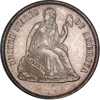 |
1869 Pattern Dime. Judd-716a. Silver, reeded edge. PCGS graded Proof 63. Only 3 known. Hint of light gold toning. This unusual pattern traces to a gentleman by the name of Koulz whose tri-metal alloy of silver, nickel, and copper, was experimented with before being dropped. The date, rather than under the seated figure on the obverse, appears at the bottom of the reverse, separated from the alloy designation by a raised dividing line. Pop 2: 3 in 64 by PCGS. (PCGS # 60942) .
Estimated Value $7,000 - 8,000.
View details and enlarged photos
Check results on similar lots
| Unsold |
Lot 804 |
|
1869 Pattern Quarter Dollar. Silver, plain edge. PCGS graded Proof 62. Blue, grey toning on both sides. Standard Silver design with a bust of Liberty facing right on the obverse. Liberty's cap is ornamented with three stars and a ribbon with the inscription LIBERTY, the motto IN GOD WE TRUST is on a scroll at the lower periphery. The reverse depicts the denomination within a wreath of oak and laurel with STANDARD SILVER above and the date below. Everything is crisp and sharp, including centers. Struck in silver with a plain edge. Pop 2; 8 finer; only 10 graded in total by PCGS. (PCGS # 60949) .
Estimated Value $1,000 - 1,200.
View details
Check results on similar lots
| Realized
$1,093 |
Lot 805 |
 |
1869 Pattern Quarter Dollar. Silver, reeded edge. NGC graded Proof 63 Pop 3; 18 finer. A dazzling brilliant white example with hints of light golden toning about the borders.
Estimated Value $1,400 - 1,500.
View details and enlarged photos
| Realized
$1,610 |
Lot 806 |
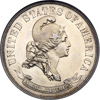 |
1869 Pattern Half Dollar. Silver, reeded edge. NGC graded Proof 63. Nice white example of this pleasing STANDARD SILVER type. Liberty is decked in a stylish liberty cap decorated with two stars; meanwhile, a ribbon inscribed LIBERTY in raised letters extends from the base of the cap across her hair. The designer's initial B within the folds of the ribbon points to William Barber (not his son, Charles) as the origin of this piece. William Barber replaced Longacre as chief engraver upon Longacre's death in January 1869. Pop 3; 7 finer. (PCGS # 60969) .
Estimated Value $2,200 - 2,400.
View details and enlarged photos
Check results on similar lots
| Realized
$2,300 |
Lot 807 |
|
1869 Pattern Half Dollar. Silver, reeded edge. PCGS graded Proof 62. Light hint of gold toning with a few tiny slide marks on the cheek. The head of Liberty wears a liberty cap with folded-over peak; LIBERTY on the ribbon is incused; B in the folds of the ribbon stands for Barber (William Barber), the coin's designer. Pop 11; 18 finer. (PCGS # 60969) .
Estimated Value $1,300 - 1,600.
View details
Check results on similar lots
| Realized
$1,323 |
Lot 808 |
|
1870 Pattern Dime. Silver, reeded edge. NGC graded Proof 65. Lovely toning on both sides. A common example from the "Standard Silver" series. There is a deep film of toning over the fields but a quick tilt will reveal brilliant toning hues on the obverse and intense reddish violet toning on the reverse. Pop 6; 3 in 66; 1 in 66 star.
Estimated Value $1,300 - 1,600.
View details
| Realized
$1,553 |
Lot 809 |
|
1870 Pattern Dime. Silver, reeded edge. PCGS graded Proof 62. Nice, untoned pattern of this popular STANDARD SILVER proposal for a subsidiary coinage. Pop 1; 6 finer; only 7 graded by PCGS. (PCGS # 61105) .
Estimated Value $1,000 - 1,200.
View details
Check results on similar lots
| Realized
$1,150 |
Lot 810 |
|
1870 Pattern Quarter Dollar. Silver, reeded edge. NGC graded Proof 66 Cameo. A glowing gem with resilient underlying luster and faint toning highlights. From center to periphery, the coin is generally well struck with just a hint of weakness at the word CENTS and the 87 in the date. Pop 1; finest cameo graded by NGC. Only 2 graded by NGC in cameo.
Estimated Value $2,500 - 3,500.
View details
| Realized
$2,760 |
Lot 811 |
|
1870 Pattern Half Dollar. Aluminum, reeded edge. PCGS graded Proof 65 Cameo. A seated figure of Liberty faces left on the obverse of this attractive design. Thirteen stars surround Liberty with the date below. She supports a shield with her right hand, and holds an olive branch in her left. A liberty pole is behind the shield and a scroll crossing the shield is inscribed LIBERTY in incused letters. The reverse is the type used for regular issue seated Liberty halves with motto. Struck in aluminum with a reeded edge. Rich aluminum-white to gray brilliance covers all of the obverse and all of the reverse from rim to rim. What's more, both sides are razor-sharp and flashy with that fresh look only pristine aluminum can impart. Pop 1; PCGS reports a total of 3; 2 in PR64 and this example as finest. (PCGS # 61183) .
Estimated Value $10,000 - 12,000.
View details
Check results on similar lots
| Unsold |
Lot 812 |
|
1870 Pattern Silver Dollar. Copper, plain edge. NGC graded Proof 66 Brown. Lovely shades of blue and brown toning. William Barber's seated Liberty design shows Liberty's right hand holding a shield, left hand an olive branch, Liberty pole behind the right elbow. The reverse is struck from regular dies with motto IN GOD WE TRUST. Sets of these handsome patterns were available in silver, copper, and aluminum with either reeded or plain edges. It is not known what price the mint charged for these. This obverse was also combined with a Standard Silver wreath reverse. Struck in copper with a plain edge. The surfaces are vibrant turquoise to deepest blue with outlines of mint red color around the stars and Liberty, etc. We see no technical flaws whatsoever, and that merits special mention since this is a spot-free rarity. Silver dollar denominated patterns are always extremely popular with collectors, and particularly when of exceptional quality in this high quality. Pop 2; none higher.
Estimated Value $7,000 - 9,000.
View details
| Realized
$9,775 |
Lot 813 |
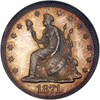 |
1871 Pattern Half Dime. Silver, reeded edge. NGC graded Proof 65. Lovely golden toning. The dies left their rigid impression behind without the least weakness or imprecision in the stars or the high relief of Liberty as an "Indian Princess" on this beloved design. At her side sits a globe of the world inscribed LIBERTY in raised letters on a ribbon. This is the Longacre design (Longacre died two years before this Pattern half dime was minted, however.).Pop 3; only 3 graded at NGC.
Estimated Value $3,500 - 4,000.
View details and enlarged photos
| Unsold |
Lot 814 |
|
1871 Pattern Half Dime. Aluminum, reeded edge. PCGS graded Proof 65. In an old green label holder. A brilliant gem example. No signs of the usual hairlines or handling marks, nor of the usual aluminum "pest" or corrosion, keeping this coin in the coveted gem class. Note the deep engraving on the dies, clearly revealed in the photos, which must have been troublesome to strike up fully. This is why the coin appears somewhat medallic in its dimensions. A fabulous Gem Proof coin for the advanced pattern collector to pursue. Pop 1: the only example certified by PCGS. (PCGS # 61326) .
Estimated Value $19,000 - 21,000.
View details
Check results on similar lots
| Unsold |
Lot 815 |
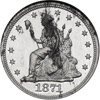 |
1871 Pattern Dime. Judd-1082, Pollock-1218. Aluminum, reeded edge. NGC graded Proof 63. An area if dark tone noted across the central portion of the obverse and lower reverse. The Longacre design with thirteen stars around the margin. This extremely rare pattern in aluminum has the STANDARD reverse. Pop 1.
Estimated Value $12,500 - 15,000.
View details and enlarged photos
| Unsold |
Lot 816 |
 |
1871 Pattern Silver Dollar. Aluminum, plain edge. NGC graded Proof 65. A gorgeous pattern with the Indian Princess struck in High relief. A minor planchet imperfection is noted near the feet. Aluminum. Plain edge. Lightly textured motifs and mirrored fields reflect faint rose iridescence on silver gray surfaces. A sharp and appealing example of Longacre's Seated Indian Princess design, here with 13 stars around in the field, and 22 stars on the flag behind Miss Liberty. Usual STANDARD reverse, denomination as numeral and word within agricultural wreath. Another prized rarity no matter how you look at it! The uspatterns.com website notes that "this is possibly unique" in regarding J-1144, and we have every reason to take Saul Tiechman, manager of the website, quite seriously when he comments on patterns. As for the coin itself, the only example of J-1144 certified by NGC, we can only speak highly. There is a touch of cloudiness in the obverse field near Miss Liberty's foot, but such is easily overlooked considering the possibly unique status of this beauty. We can't imagine any serious pattern dollar specialist missing an opportunity to bid on the present gem. NGC Pop 1.
Estimated Value $40,000 - 45,000.
View details and enlarged photos
| Unsold |
Lot 817 |
|
1871 Pattern Silver Dollar. Copper, reeded edge. NGC graded Proof 66 Brown. Lovely shades of light green, light blue and copper. Liberty facing left, wearing an Indian headdress with a Liberty pole in her right hand, her left rests on a globe inscribed LIBERTY; 1871 below, 13 stars surrounding. The reverse is the same design used on regular silver dollars of the year. A splendid example with glittering surfaces, plus razor sharp strike. Extremely popular design and denomination. Pop 1; finest brown graded by NGC.
Estimated Value $7,000 - 9,000.
View details
| Realized
$9,775 |
Lot 818 |
 |
1871 Pattern Half Eagle. Aluminum, reeded edge. PCGS graded Proof 64. A faint hairline in the lower left obverse field, plus natural aluminum toning in the hair and coronet area of Liberty. This is an extremely well-struck example with excellent details. It has no bothersome abrasions or points of wear; moreover, the dies left their rigid impression behind with razor-sharpness and precision only seen on the best made pattern Proofs.
Nearly every year until the early 1880s the Mint produced "regular dies trial pieces" as numismatists refer to them. Whether made to test the dies -- or simply for sale to collectors as profitable novelties -- they are usually in softer metal than the production coin (which seems to point to the former); however, some trial pieces were struck in much harder alloys, and may have been pure pieces d' caprice. Pop 1. (PCGS # 61434) .
Estimated Value $20,000 - 24,000.
View details and enlarged photos
Check results on similar lots
| Unsold |
Lot 819 |
 |
1872 Pattern Eagle. Judd-1249, Pollock-1391. Aluminum, reeded edge. PCGS graded Proof 63. Excellent cameo contrast. The surfaces are a aluminum bright, with deep bright sparkling luster complemented by the frost on the devices. Struck with exactitude always found on these "regular dies trial pieces" and as such, a marvelous example. There is a small area of contact in the field below the chin, also some scuffs on the nose and in the adjacent field, all of which are consistent with the grade. Pop 1. (PCGS # 61521) .
Estimated Value $22,500 - 27,500.
View details and enlarged photos
Check results on similar lots
| Unsold |
Lot 820 |
 |
1873 Pattern Cent. Aluminum, plain edge. PCGS graded Proof 66. A dazzling gem! Well detailed for this more difficult Pattern issue, with gorgeous aluminum-gray highlights that add considerably to the appeal of this remarkable defect-free Gem. Pop 1. (PCGS # 61541) .
Most die trial pieces were made in limited numbers. Since these were intended solely to test the dies, or to be used as gifts for collectors, and there was no consideration give to distributing them to Congressmen so as to influence a decision for a design change, only a small number were made. Judd estimates 4 to 12 known (Rarity-7) for the typical die trial piece, of which this 1873 aluminum cent is a priceless example. As a consequence, only a small number of collectors can own these at any one time.
Estimated Value $25,000 - 27,500.
View details and enlarged photos
Check results on similar lots
| Unsold |
Lot 821 |
|
1873 Pattern Half Dollar. Aluminum, reeded edge. NGC graded Proof 66 Cameo. Flashy white coin. Struck in aluminum. Obverse and reverse: The dies used to coin regular-issue Proof coins this year. Lustrous sleek aluminum-gray surfaces with rich frosted-cameo highlights. Absolutely full strike on the reverse eagle. Incomparable detail on Liberty as well, the date digits and the stars. A truly impressive gem Proof specimen of a rare off-metal strike from 1873. Pop 1; finest graded.
Estimated Value $9,000 - 11,000.
View details
| Realized
$16,100 |
Lot 822 |
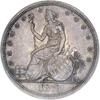 |
1873 Pattern Trade Dollar. Silver, reeded edge. PCGS graded Proof 58. Even greyish toning. Light mishandling and wear but generally choice appearing and also very sharply made for this Judd variety. Scarce. Pop 1; 31 finer (PCGS # 61578) .
Estimated Value $1,600 - 2,000.
View details and enlarged photos
Check results on similar lots
| Realized
$2,070 |
Lot 823 |
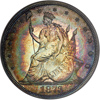 |
1873 Pattern Trade Dollar. Silver, reeded edge. PCGS graded Proof 64. Lovely rainbow toning on both sides. This attractive Trade Dollar design shows Liberty seated on the obverse with an Indian headdress on top of her head, Liberty pole and cap in her right hand, left hand resting on a globe, and two flags behind. The reverse has a small eagle in the upper half with most of the statutory legends above and below, two of which are on scrolls. Struck in silver with a reeded edge. Deeply mirrored with considerable mint frost on the devices, each side is nicely toned as described. Examples of this variety were included in a six-piece Pattern Trade Dollar set distributed by the Mint. Pop 10; 2 in PF65. (PCGS # 61596) .
Estimated Value $6,000 - 7,500.
View details and enlarged photos
Check results on similar lots
| Realized
$9,775 |
Lot 824 |
|
1873 Pattern Trade Dollar. Silver, reeded edge. NGC graded Proof 66 Cameo. Frosty white gem. Meticulous strike on every device is what collectors look for in a rare Pattern, but this coin doesn't quite make the "full" grade since portions of the eagle are slightly weak due to the juxtaposition of high points on the opposite side. Just the same, the numerical condition is exact and obviously was carefully weighed by the grading service. This marvelous example has shimmering surfaces and no toning. Pop 1; finest cameo example graded.
Liberty seated facing left, 13 stars around 1873 below, Liberty supports a pole surmounted by a liberty cap with her right hand her left rest on a globe inscribed LIBERTY, two bales of cotton and a tobacco plant at her feet. Reverse, small eagle facing right standing on a shield holding three arrows in left talon and olive branch in right. Designs by Joseph A. Bailly.
Estimated Value $10,000 - 12,000.
View details
| Realized
$17,250 |
Lot 825 |
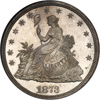 |
1873 Pattern Trade Dollar. Silver, reeded edge. NGC graded Proof 63 Cameo. Liberty seated facing left, 13 stars around 1873 below, Liberty supports a pole surmounted by a liberty cap with her right hand her left rest on a globe inscribed LIBERTY, two bales of cotton and a tobacco plant at her feet. Reverse, small eagle facing right standing on a shield holding three arrows in left talon and olive branch in right. This is a choice and attractive example with fully brilliant Proof surfaces, the fields nicely mirrored while the devices are highly lustrous. Some light hairlines. Although considered a "plentiful" Pattern issue, we have difficulty imagining assenbling even two dozen of these in the lifespan of the average person. Pop 3; 3 finer.
Estimated Value $5,500 - 6,000.
View details and enlarged photos
| Unsold |
Lot 826 |
|
1873 Pattern Trade Dollar. Copper, reeded edge. PCGS graded Proof 65 Brown. This piece is similar to the adopted design but the base of the ocean waves is longer and extends to the serrations. On the reverse, the engraver has placed a small eagle with raised wings holding in the right talon an olive branch and three arrows in the left; there is a scroll inscribed E PLURIBUS UNUM in its beak. Pop 2; only 2 graded in total by PCGS. (PCGS # 61610) .
Estimated Value $10,000 - 12,000.
View details
Check results on similar lots
| Realized
$12,650 |
Lot 827 |
|
1873 Pattern Trade Dollar. Copper, reeded edge. PCGS graded Proof 65 Brown. Chocolate brown color. A resplendent Gem brown Proof of this design, similar to the last, but struck in copper. Pop 2: only 2 graded by PCGS; Both in this sale (PCGS # 61610) .
Estimated Value $10,000 - 12,000.
View details
Check results on similar lots
| Unsold |
Lot 828 |
|
1874 Pattern Eagle. Copper, reeded edge. NGC graded Proof 66 Brown. Dana Bickford's International Ten Dollar piece. The obverse contains a bust of Liberty facing left with the legend UNITED STATES OF AMERICA above and the date below. In her hair there is a diadem inscribed with the word LIBERTY, ornamented with six stars. The weight 16.72 GRAMS, the standard of the metal 900 FINE, and the word UBIQUE are centered on the reverse. Around the periphery is the U.S. denomination DOLLARS 10 and the following international equivalents: STERLING (Pound) 2.1.1; MARKEN 41.99; KRONEN 37.31; GULDEN 20.73; and FRANCS 51.81. Struck in copper and a reeded edge. The Bickford $10 is one among several proposals for an international coinage; another was the 1868 half eagle pattern, the 1879-80 $4 Stellas and $20 DEO EST GLORIA pieces. While having the diameter of a double eagle, these pieces were struck on slim planchets. This particular example appears with attractive purple to blue-brown iridescence; there are one or two field marks and a hairline through the portrait into the field below the U of UNITED, that are mostly obscured by the attractive toning. No other post-striking impairments on either side and the coin is very attractive with remnants of the originally striated fields still in evidence with magnification. Pop 1; the only graded at NGC.
Estimated Value $10,000 - 14,000.
View details
| Realized
$15,525 |
Lot 829 |
|
1877 Pattern Half Dollar. Silver, reeded edge. NGC graded Proof 63. Morgan's "silver dollar style". Bright silver centers give way to rich halos of deep gold, violet, and rose. Obverse extraordinarily similar to that of the Morgan dollar which followed for general circulation in the next year 1878. Lightly cleaned at some time in the past, since naturally retoned. The present specimen is perhaps No. 1 of the three pieces enumerated at the uspatterns.com website. There No. 1 is listed as: "Farouk-Sotheby's 2/54?; Empire Topics #3; Cox-Stacks' 4/62?; MARCA 5/87; B & M 5/92, was PCGS-62; Superior 2/05 (not sold), NGC-63-cleaned." Accordingly, this particular specimen of this important rarity possibly originated in the Sotheby's sale of King Farouk's Collection in 1954; surfaces suggest that it is, indeed, a Farouk coin. As noted above, the presently offered coin has long since recuperated from its light cleaning, and, even with that in mind, it is still a major rarity among pattern issues. The present choice Proof is the only example of Judd-1504 certified by NGC in the Proof designation; two other examples of Judd-1504 have been certified by that firm, one of those was with a Cameo designation, the other with a Ultra Cameo designation. We suspect more than one specialist will bid boldly for this numismatic treasure.
NGC Census: 1; none finer within the designation; 2 higher as "Cameo" and "Ultra Cameo" Proof 63s.
Estimated Value $18,000 - 20,000.
From Bowers and Merena's sale of the Somerset Collection, May 1992, Lot 1752; earlier Mid-American, May 1987, Lot 2125;.
View details
| Unsold |
Lot 830 |
 |
1877 Pattern Half Dollar. Copper, reeded edge. PCGS graded Proof 63 Red & Brown. Rich blue and carmine details on Miss Liberty's portrait and the reverse eagle sits serenely amidst subdued orange-red mirror fields. Cleaned long ago, long since naturally retoned. One of just three or four examples thought to exist, the uspatterns.com website suggests that the present specimen is the Pollock plate coin in the pattern reference by that author, but a quick comparison shows it clearly isn't that specimen. Regardless of which specimen it is, the coin is downright rare! One of just two examples of J-1521 certified by PCGS, a true insight into this variety's rarity. We suggest you bid as though you mean it when this rare dainty crosses the auction block, for once absorbed into a major collection, it may be some time before it again sees the light of day.
PCGS Population: 1; 1 finer within any designation (Proof-66 RB). (PCGS # 71859) .
Estimated Value $15,000 - 17,500.
View details and enlarged photos
Check results on similar lots
| Realized
$17,250 |
Lot 831 |
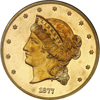 |
1877 Pattern Fifty Dollars or "Half Union". Judd-1549. Copper (gilt), reeded edge. NGC graded Proof 64. Possibly the finest copper known. PCGS graded 2 in PF-63. Only 3 known. Two graded by NGC PF63 and PF64. Copper, gilt. Reeded edge. Light hairlines in the field, but essentially mirrorlike. Well struck and with excellent contrast. A beautiful example of a pattern variety that is unobtainable in gold, accessible only in copper or copper gilt, and rare as such. The current piece was struck as copper and then was gold plated very early, possibly at the mint (as was done every now and then), possibly not. The record is ambiguous. Fewer than 10 different examples have been traced today of Judd-1549, making the present coin a rarity in an absolute sense. Interestingly, more gilt examples of Judd-1549 are known than are copper pieces (while for J-1547, the opposite is true). Although today classic "trophy coins" have a way of bouncing around on the market and appearing more frequently than their rarity indicates, most 1877 pattern $50 pieces have remained rather quiet.
The $50 Half Union, as it was called, was the result of a proposal made to create a large gold coin for commerce, in view of quantities of bullion being available from California. The denomination has precedence in that decades earlier in 1851 and 1852 octagonal $50 "slugs" were produced in San Francisco, and in 1855 the famous Wass, Molitor, & Co. and the rare Kellogg & Co. $50 pieces were made in round format. The thought in 1877 was to have the $100 be called the Union, and the $50, as here, called the Half Union.
The design and dies were made by Chief Engraver William Barber, who inserted his initial B below the curl at the back of the neck truncation. The portrait of Liberty is instantly familiar as the same motif, in various reductions, was used on his other patterns, notably dollars through and including 1880. The head of Liberty superficially resembles that on current $20 pieces, but is strictly Barber's own work, with stylistic variations and with the coronet of an unusual configuration. The date 1877 is from the four-digit logotype used to produced double eagles this year. The stars around are small and are no doubt standard punches used on a smaller denomination.
The reverse is directly inspired by the contemporary $20 piece, designed by James B. Longacre in 1849, but here in larger size and adapted for the $50. Appropriate lettering is around the border as illustrated. The motto IN GOD WE/TRUST was probably entered into the die by hand, rather than being part of a hub. The alignment is rather irregular, the top line is not in a true arc, the D is distant and tilts to the right, and so on. The devil is in the details, they say, and often the examination of a seemingly routine pattern or regular die from this era of the 19th century will reveal many irregularities.
As to the $50 pattern, there are two different obverse dies, both combined with the reverse here. One striking of each was made in gold, and given to the Mint Collection. However, it seems that in the early 1890s Philadelphia dealer John W. Haseltine somehow persuaded the curator of the Mint Cabinet to part with them, after which they landed in Haseltine's inventory. The same gold impressions reappeared on the market in the next decade when he and Stephen K. Nagy sold them to William H. Woodin. A great furor arose, well delineated in the numismatic press of the time, and the two gold strikings were returned to the Mint. Today they are among the treasures in the National Numismatic Collection at the Smithsonian Institution.
The number of copper pieces struck was not recorded, but must have been quite low, judging from the rarity of such pieces today. The presently offered coin reflects not only an idea that might have been, but wasn't, but also is desirable for the $50 denomination (the toughest value to acquire for a type set of patterns), its rarity, and its fame.
Estimated Value $200,000 - 220,000.
View details and enlarged photos
| Realized
$230,000 |
Lot 832 |
 |
1878 Pattern Eagle. Copper, reeded edge. PCGS graded Proof 66 Red. Fiery mint red. The finest certified of this extremely rare Pattern half eagle, a blistering red colored coin with beautiful features. The design of William Barber, Judd-1580 introduces a head of Liberty wearing a large cap ornamented by two heads of wheat and with LIBERTY incused on the band; IN GOD WE TRUST above. The reverse eagle stands with raised wings holding an olive branch with seven leaves in the right talon and three long arrows in the left; E PLURIBUS UNUM above the wings. Rarity-7 in copper, of which some are gold plated, which, to a certain contingent of Pattern collector, lessens their prestige. Pop 1 with none better. (PCGS # 81944) .
Estimated Value $35,000 - 40,000.
View details and enlarged photos
Check results on similar lots
| Unsold |
Lot 833 |
|
1879 Pattern Half Dollar. Silver, reeded edge. NGC graded Proof 66. Lovely blue and gold toning. Barber's Washlady motif is featured on the obverse. The head of Liberty faces left with IN GOD WE TRUST above and the date below. The reverse depicts an eagle with spread wings holding an olive branch in one talon and three long, slender arrows in the other. The legends surround the eagle, with the denomination below. Struck in silver with a reeded edge. Golden-rose color is seen over most of each side, lighter in the centers and deeper toward the rims, with deep cobalt-blue and sea-green around the peripheries. Nicely mirrored in the fields, we see no surface flaws that would aid in tracing this coin's pedigree, just slight irregularities in the pattern of the toning. Only one other piece has been so graded by the major services with none finer. Pop 2; tied for highest graded at NGC; only 3 graded by NGC.
Although the new dollar had been accepted the year before, ten more pattern dollars were minted in 1879. Charles E. Barber submitted his "Washlady" design not only for the dollar but for the half dollar, quarter dollar and dime. Geoge T. Morgan, his associate at the mint but also a competitor designed the "Schoolgirl" pattern dollar; he also combined his obverse adopted for the regular Morgan silver dollar with other reverses for pattern dollars, half dollars, quarter dollars and dimes.
Estimated Value $20,000 - 25,000.
View details
| Unsold |
Lot 834 |
 |
1879 Pattern Dollar. Silver, reeded edge. PCGS graded Proof 65. Lovely multicolor rainbow toning on both sides. The exquisite Schoolgirl Pattern, struck in silver with a reeded edge. A bust of Liberty faces left, and her hair is combed back and is tied with a ribbon. In the hair, a hair band inscribed LIBERTY, which is placed much higher than on most other Liberty head designs. A string of pearls is around her neck. E PLURIBUS UNUM and the date are separated by thirteen stars, similar to the Morgan Dollar obverse border although E PLURIBUS is higher on this pattern. The reverse features a defiant eagle standing with raised wings on a wide scroll inscribed IN GOD WE TRUST. The conventional heraldic olive branch and arrows are on opposite sides of the scroll. UNITED STATES OF AMERICA and ONE DOLLAR are arranged along the border much like on the regular issue Morgan Dollar.
The Schoolgirl design is widely acknowledged to be one of the most impressive Pattern designs. Credited to George T. Morgan, who was a relatively new arrival at the U.S. Mint. Competition between Morgan and Charles Barber led to several interesting designs in 1879, with the Schoolgirl, Washlady, and Stella patterns among the most notable of these. The present example is razor-sharp and boasts magnificently preserved mirror surfaces. Gorgeous honey-gold colors outline the borders and devices with their dappled effect, while the fields and portrait mainly display medium pearl-gray to bright silvery patina. The eye appeal of this lovely Gem Proof 65 is truly exceptional, and its rarity is unquestioned.
Pop 2; 1 in 66. PCGS has graded only 6 pieces in total (PCGS # 61986) .
Estimated Value $100,000 - 125,000.
View details and enlarged photos
Check results on similar lots
| Realized
$109,250 |
Lot 835 |
|
1884 Pattern Cent. Nickel, plain edge. PCGS graded Proof 66. Eastman Johnson's annular design for the cent with the center perforated with an irregular circumference. These experimental pieces were intended to make small denomination coinage easier to distinguish by the blind, and thereby to "remedy the inconvenience of similarity in our small coin." The obverse bears the words UNITED STATES OF AMERICA about the upper rim and the date at the bottom. The reverse shows the denomination ONE CENT at the top with an inverted shield and two laurel sprigs below. Struck in nickel with a plain edge. This gold and gray tinged example is noticeably reflective in the fields with no carbon spots or hairlines. A no-questions Gem with pleasing eye appeal. Pop 11; 6 in 67. (PCGS # 62150) .
Estimated Value $2,500 - 3,000.
View details
Check results on similar lots
| Realized
$2,300 |
|
|